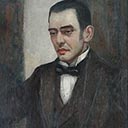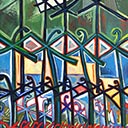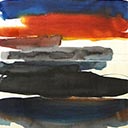Torso G
58 x 55 cm
est. $35,000 - 45,000
Provenance:
Purchased from Barry Lett Galleries, 1978
Fletcher Trust Collection
Illustrated:
Art New Zealand, Winter 1978
Pat Hanly's Torso G comes more than a decade after he returns from five years in Europe and marks a time in his career when he said that everything, all the strands he had been working on, were coming together. The painting holds within it the discoveries and achievements of several preceding series: the coastal light of Figures in Light; the tenderness of Girls Asleep; the atomised forms and transparency of Inside the Garden and Molecular; and finally the mature balance between figure, ground, line and flat, intense colour of The Golden Age.
Torso G was first shown at Auckland's Barry Lett Galleries early in 1978 and reproduced in Art New Zealand in the same year. It is tempting to see the 'G' in the upper left corner as referring to the artist's wife Gil; and perhaps the 'T' as Gil's maiden name Taverner, or their daughter Tamsin's initial, or standing in for the 'Torso' of the title - or all three. Whichever, Torso G is Pat Hanly at the top of his game, and evidence that, as his wife Gil Hanly says "he knew absolutely what he was doing".
However, arriving at a painting such as Torso G was not plain sailing for Hanly. There were struggles: Gil Hanly recounts how the artist laboured through periods when he felt blocked; being worried he was too influenced by what he was taught at art school; and a difficult"floundering around"period following his return to New Zealand when he could not really get his eye in after the sunless but otherwise frenetically stimulating years in the UK, Holland and Italy. To compound these struggles, his habit of destroying works he was not happy with (even buying them back to do so) is well-known. Probably, and most importantly, it was 'the darkness' that gave birth to this painting and others of its quality from this period. 'The darkness' as Pat Hanly called it, was a reductive technique that he devised trying to unlearn what he'd learnt at art school and to see things afresh. He had a studio in Grafton where he blacked out the windows and worked entirely in the dark; turning on the light later to discover what he'd done. This process was both productive and thrilling.
ROB GARRETT





